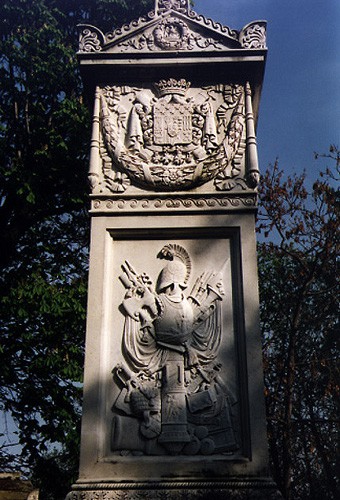As a result of the law of 23rd Prairial (21st June) year XII (1804)
prohibiting burial in churches, convents and cemeteries within the
city walls, Nicolas Frochot, who had been prefect of the Seine
since 1800, decided to create four Parisian necropolises situated
outside the walls and at the four points of the compass. Only
three of the necropolises were built, one to the North, one to
the South (both based on existing cemeteries) and one to the
East on the Charonne hill. Forty-three acres (17 hectares) of
that hill were purchased by the city of Paris for 180,000 francs,
land from the Montlouis estate, the former property of the
Jesuits of rue Saint-Antoine where the father-confessor to
Louis XV, Père La Chaise, took refuge from 1665 to 1709.
Frochot commissioned the architect Brongniart to prepare the
terrain for its new function. Brongniart created a new type
of cemetery in harmony with the Romantic aspirations of the
epoch. Intelligently, he chose to maintain the contours of
the site with its abundant vegetation whilst laying paved
walkways between the graves, as a sort of invitation to a
melancholic stroll. At the same time, he conceived of the
grandiose project for a covered gallery designed to protect
the graves, preceded by a courtyard; so impressive was the
plan that even the government reserved a space for national
heroes. But the uniformity that was imposed in the design
of the tombs was deemed unsuitable and so the cemetery administration
came back to the idea of concessions. In 1805 permanent concessions
were established.
The first burial at Père Lachaise, that of a five-year old
little girl, took place on 21st May, 1804, but the cemetery
did not find favour with the public. Many Parisians were
doubtful about being buried on a hill and, what's more,
outside Paris. It was to take the transfer of a few prestigious
remains to attract the elite from the capital. Napoleon had
the remains of Louise de Lorraine, wife of Henri III (and later
of Admiral Bruix) transferred there. The trend was started:
the number of permanent concessions increased from 49 in 1806
to 62 in 1807 to reach a total of 833 in 1812. The transfer
of the supposed remains of La Fontaine and Molière as well as
the tomb of Héloise and Abélard in 1817 confirmed this success.
The cemetery was to be enlarged six times before reaching in
1850 its current dimensions of 110 acres (44 hectares). In 1856,
Napoleon III established a Muslim enclave with a mosque but
because of its lack of success, the grove was in part replaced
with a dovecote and the mosque destroyed in 1914.
The cemetery was twice the scene of tragic historical events.
The first time was in 1814, when the Russians bivouacked there after having
wiped out the students from the military academy who had been
entrenched there and the second ocurred during the Commune period when
the last Fédérés were massacred by the Versaillais. The “Mur
des Fédérés,” (Fédérés wall) on the East side of the cemetery
is a memorial to this terrible episode.
Père Lachaise is an open-air version of the Panthéon (the
central-Paris monument dedicated to great historical figures),
a veritable museum of 19th-century funerary sculpture
situated partly in an English garden. Hundreds of personalities
of the First Empire can be found in the 97 divisions that go
to make up the cemetery. Enthusiasts of militaria can find
in the 28th, 29th, and 38th divisions
the burial places of the great generals and marshals of the
Empire: notably, Davout,
Foy (who reposes in a mausoleum in the antique style designed
by Vaudoyer and decorated with sculptures by David d'Angers),
Lefebvre, Masséna, Ney, Kellermann (30th division), Gobert
(37th division – a striking equestrian statue represents him
being struck down on the battleground), Murat (his memorial
is recorded on a commemorative plaque on the familial tomb),
Sérurier, Suchet, Gourgaud (23rd division), etc. The political
personalities are legion – Roederer, Lebrun, Lakanal, Gaudin,
Barras, Sieyès, Cambacéres, Decrès – as are the scientists and
scholars – Bichat, Cuvier, Champollion, Geoffroy de Saint-Hilaire,
Gay-Lussac, Chappe, Larrey, etc. The artistic world is also well
represented, with architects (Brongniart, Percier and Fontaine),
sculptors ( Bosio, Cartellier, David d'Angers), painters (David
, Isabey, Ingres, Géricault, Girodet, Gros), musicians (Cherubini,
Garat, Méhul, Gossec), not to mention Talma, Vivant Denon and
many more. Those who love scandal could make a more unusual
pilgrimage in search of the Emperor's mistresses: Mesdemoiselles
Bourgoin, Duchesnois, George, Mars, all actresses, madame Saqui
(the tightrope walker), Pauline Fourès (the “Egyptian” lover),
Eléonore de la Plaigne, mother of the comte Léon and finally
Marie Walewska whose heart rests in her husband's
Père Lachaise Cemetery


